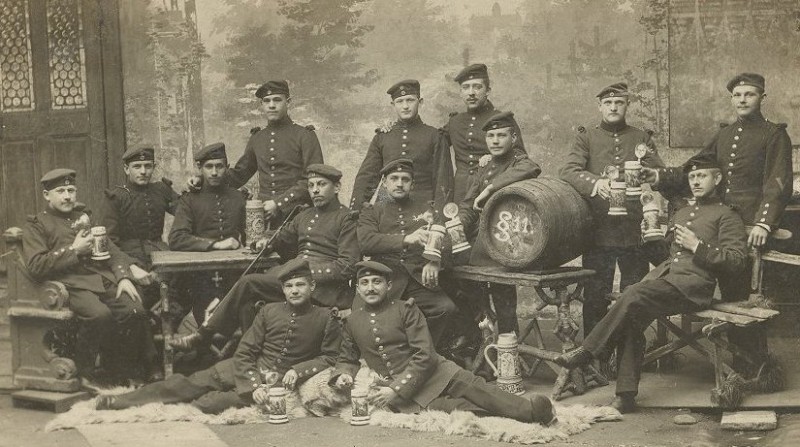
** Imperial German soldiers and their “Reservist” beer steins (they were leaving active duty and would become reservists for many years.) The photo is circa 1911. **
As a result of the popularity of the American GIs collecting the original “Imperial Era” Reservist steins in Germany after WWII and during our occupation of that country, various German stein manufacturers started to produce reproduction “Regimental” steins.”
Now these reproductions are flooding the internet sales sites, advertised as being authentic (and some do look a lot like the originals.) I did a quick survey the other day of “Regimentals” advertised as the real thing on eBay. The results were: 1 @ $550.00; 2 @ $400.00; 4 @ $250.00; 6@ $200.00 / $195.00; and 4 between $165 and $110.00! These prices are way to high for beginning collectors to “get stuck” for I think.
Therefore, these pages should give the new collector a better understanding of the reproduction problem, and hopefully save him / her some money.There are a total of four pages of information.
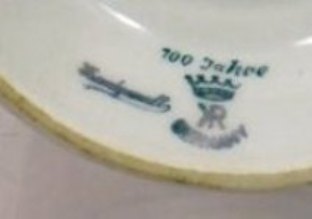
Marks on the porcelain steins of Karl Rau (1945-1978.) First located in Munich, then moved to Schonfeld, in Bohemia. (My thanks go to Ron Gray [SCI] for that info) He indicates that firm decorated (but not made) their two tiered lidded steins well before the formation of West Germany in 1949. Some of these are quite well made and many a beginning collector has been easily fooled.
Some major ‘give aways’ of the reproductions are:
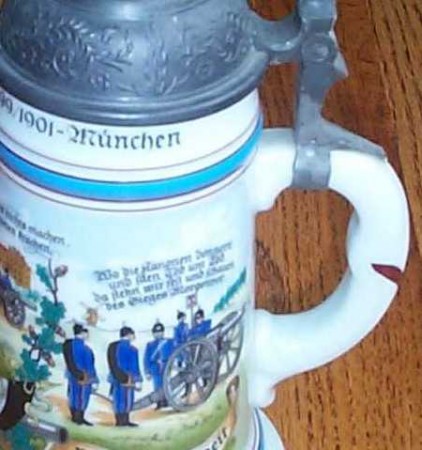
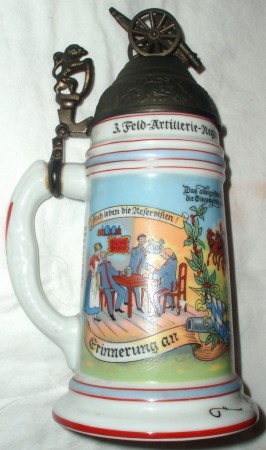
[1] A lump / bump on the inside of the handle. Left and right above: two versions of one hump (notice the top of handle is different too) [OR] four smaller bumps (groves) for one’s fingers, like a pistol grip.
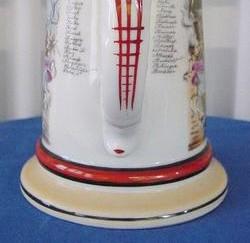
[2] A flared out bottom with slanted sides (some early original reservists had slanted sides also but not with the very wide bottom.) Most of the newer reproductions do not have this, and have a shape like a tin can (cylindrical.)
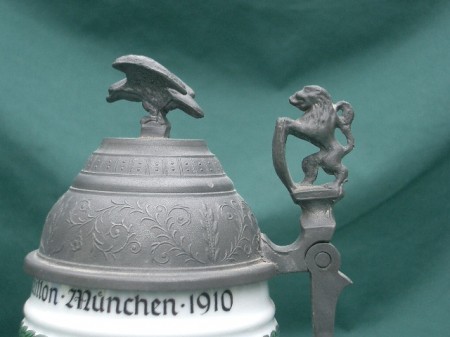
[3] Has a very poorly cast rampant lion holding a shield, as a thumblift (called the “Crappy Lion” by some.)
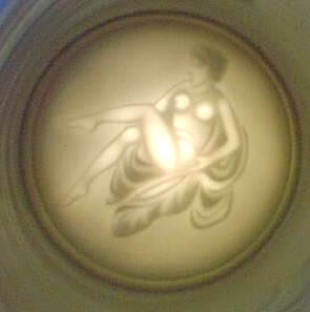
[4] The lithopane is of a nude woman with a drape around her (there are now at least 5 versions of this) in the lithophane =the porcelain light picture at the bottom of the stein. Also look for an alpine couple dancing, or a man caressing a woman’s breasts in the ‘litho’.
See: “Gerold Porcelain” in this sites Compendium for “G.”
Shown BELOW are some of the lithophanes now found on modern reproductions that were NEVER used in the originals.
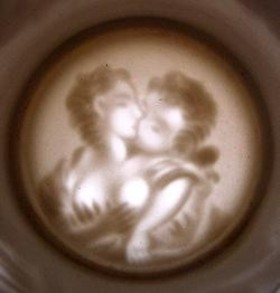
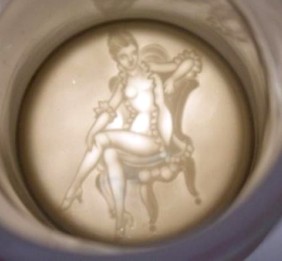
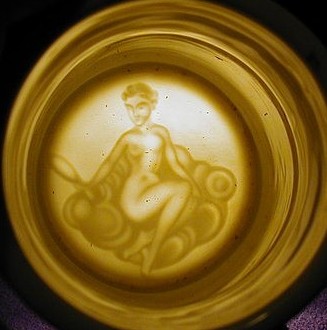
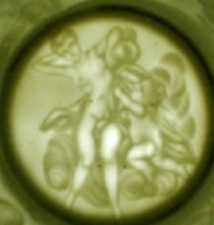
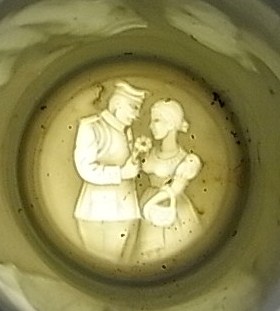
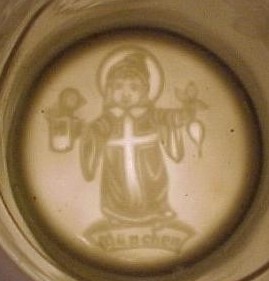
.
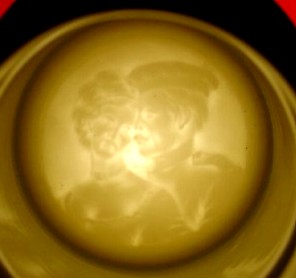
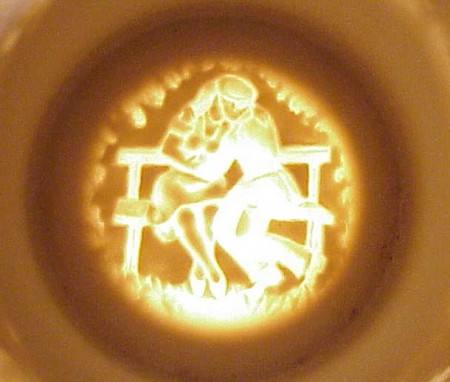
COUPLES KISSING WERE NEVER ON THE ORIGINALS!!
.
See more on “Repro lithos, Woman and soldier saying goodby.” on Page 3.
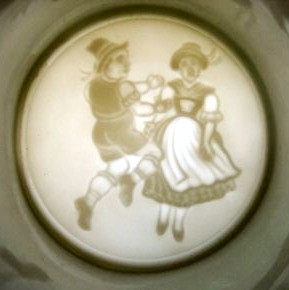
Also see: “Gerold Porcelain” in this sites Compendium for “G.”
[5] A chemically darkened inside of the lid.
This color matches the outside color of the lid as both sides were dunked in a “pewter stain ” to simulate age. Originals would be shinny on the inside as they were not exposed to the air, due to the lid being closed most of the time. (Most outsides of the lids on originals are not as dark as the chemically treated ones either.) [No photo needed]

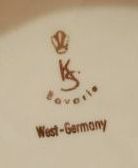
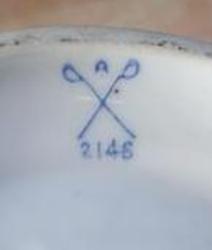
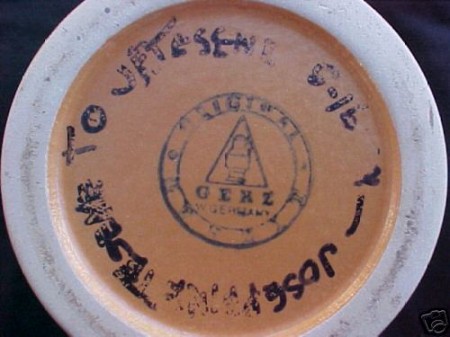
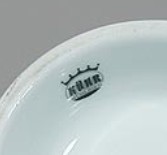
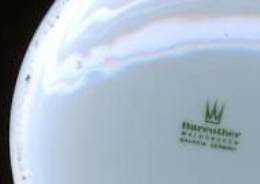
[6] Any mark showing country of origin or Company logo such as a crown with ‘K (reversed) and R’ = Karl Rau. As originals were not made for export in the early 1900s, these marks will never be found on them. The originals may have a decorator’s shop name on them, usually somewhere around the handle and “almost never” on the inside of the bottom (In now 41 years, I have seen only one done that way, on a dated 1895 stein. )
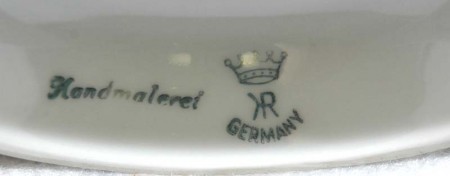
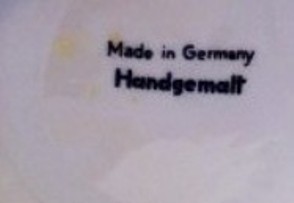
[7] There is printed on the bottom (mostly in blue) “Handmalerei”; “Handgemalt”, or “Handdekorient”; all meaning handpainted, either with, or w/o the mark.
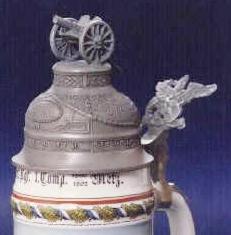
The Baden Griffin thumblift applied to a Bavarian striped (blue and white) repro stein.
[8] Has the State of Baden thumblift. A majority of later reproductions (made in 1990’s and on) have the flat Baden “Griffin” thumblift, regardless of the mentioned state (Bavaria, Hesse, etc,) shown in the unit designation or any state colors shown. (Bavaria’s colors were blue and white; Hesse was red and white; Baden’s were red and yellow; and Wurrtemberg’s were red and black.) This is becoming more and more common! It must be the easiest and cheapest thumblift to make now-a-days as it is mostly flat and can be made easily.
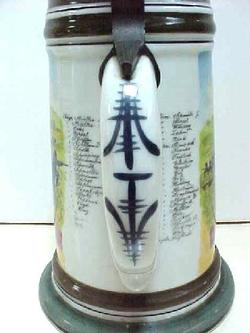
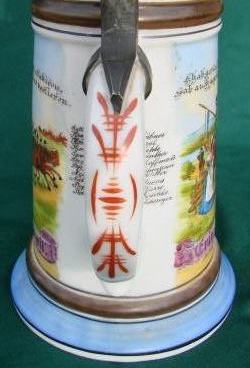
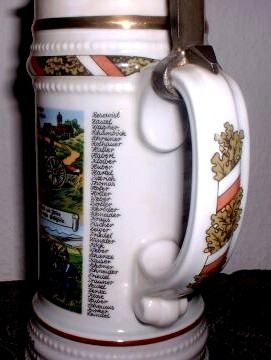
[9] Fancy (looking like Chinese letters) painted decorations, including small “state stripes.” on the handle.
.
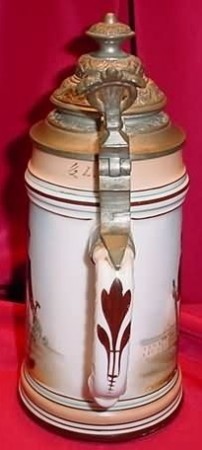
Some turn of the century ‘originals’ have a small reddish-maroon flower like devise, sort of like a fleur-de-les, but with more leaves. Shown: 1893 original reservist’s handle decor.
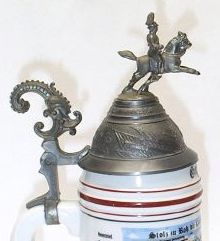
[10] A “cone” shaped lid, not a rounded dome as on the originals, and it has very little support for the finials. See #12’s lid below too.
[A] 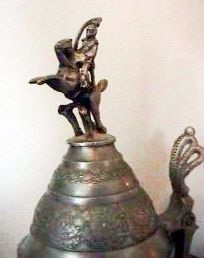 [B]
[B] 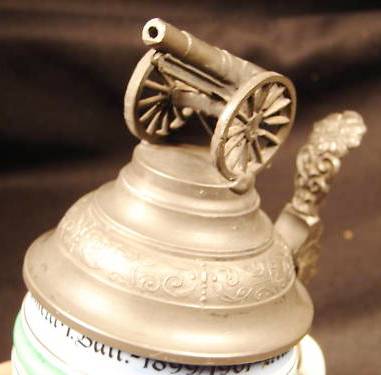
[C] 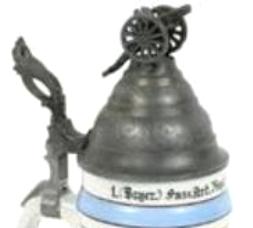
[11] [A] Fan thumblifts (four vertical openings on the thumblift, with tiny ball on top in the middle), and [B] Flat florals are on some early reproductions, and as shown above with a type of “rounded cone lid.” [C] A floral type thumblift with an opening in its middle.
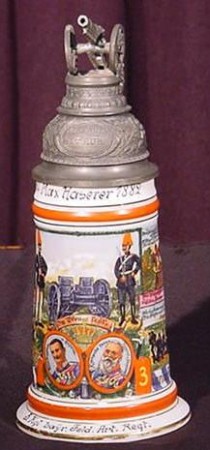
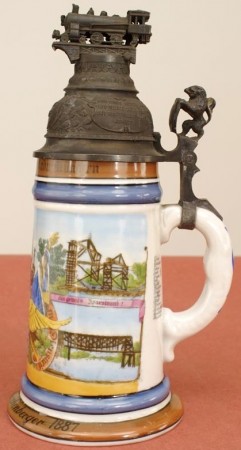
[L] Dated 1880 – 1882 [R] Dated 1885-87
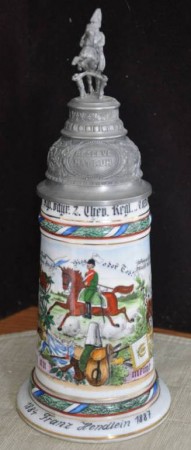 Dated 1884 -1887
Dated 1884 -1887
[12] Some of the double tiered lid steins have very early dates, such as 1881-83 or through the years 1891 to 1893, BUT porcelain steins of this size with those large finials weren’t produced until about the 1900’s.
, 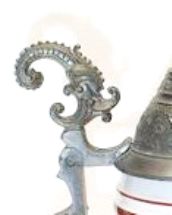
[13] A grotesque face shaped like a half moon with balls as a thumblift. These are never found on originals.
______________________________________________________________________________
[14] Writing saying either “Germany” or “West Germany” (which began 1949 – ended 1990.) This automatically means a “repro” as this would apply to exported items. [No photo needed]
_______________________________________________________________________-
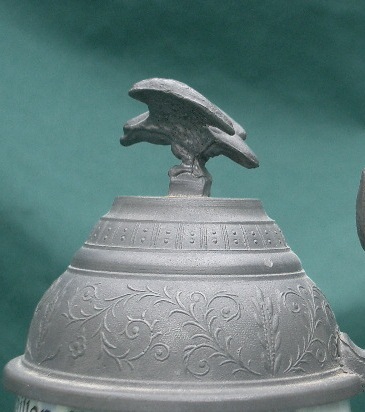
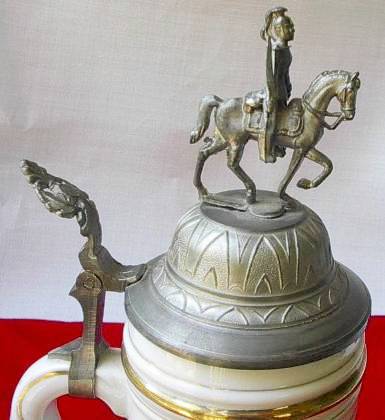
[15] Very nondescript and thin relief work on the lids. (Also see#11 AND #12 on page 1.}
________________________________________________________________________
[16] Incorrect number of years shown for type of service. For example Infantry and Pioneer service was two years, any service caring for a horse was three years; and service in the Navy was three years. [No photo needed]
______________________________________________________________________
[17] A very small amount of painted dots or stripes on the main scene (a decal) to give the appearance of being hand painted. Originals had lots of applied paint on them, easy to feel. [No photo needed]
_______________________________________________________________________
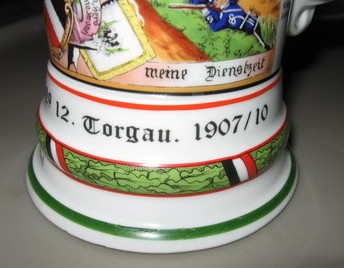
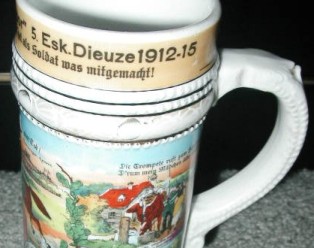
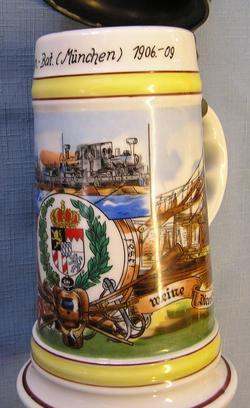 A Pioneer – Has unit designation, but no name!
A Pioneer – Has unit designation, but no name!
[18] No difference in the writing within the unit designation. On the original steins from about 1900 the unit designation was hand painted into a blank space in the decaled (transfer) inscription. Usually the last two years were hand painted also. The style of the hand lettering is most often a little bolder and different than the decal.
However PLEASE read the news on page 3 of this document [Reservist’s (Regimental) reproductions. How to tell] with the photo reproduction steins being produced now; these dates look 100% correct!
If the unit designation is written in small black ink “script” and curved around the front panel, the stein is probably original, and would have an early date = pre 1900. This “script” would appear to be all the same and an exception to what I just said above .
________________________________________________________________________
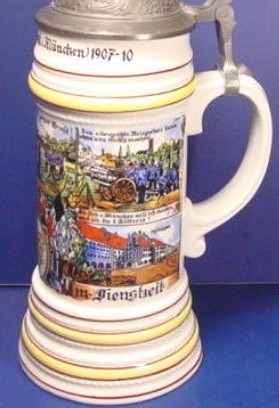
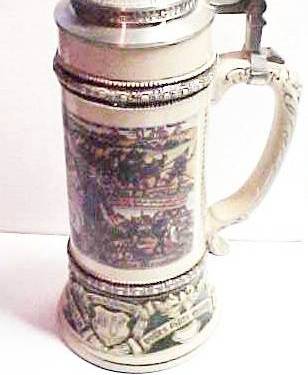
[19] The Reservist’s name and unit info is not on the stein. Nor are the dates of service on some = right above .
__________________________________________________________________________
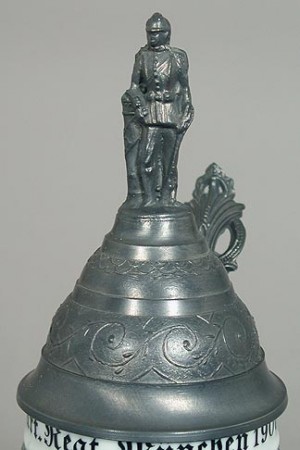
[20] The pewter casting of the finial and thumblift are very indistinct, especially the finial with the soldier standing next to a post (an original State of Bavaria indicator.) The new ones are so poorly cast one can not make out a face on the soldier!
_______________________________________________________________________
[21] BELOW: Incorrect lid finial compared with the scenes represented on the body.
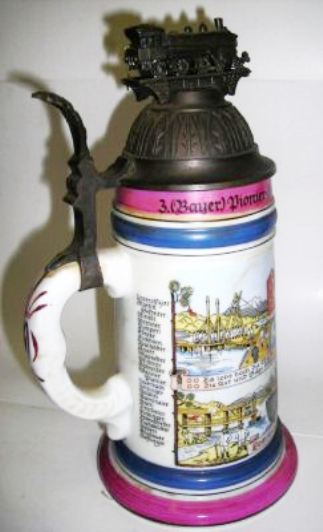
[A] named to a “Pioneer” and showing a locomotive finial which would be for the “Eisenbahn, (Railroad.)” And please note the great [?] color combination on the body!
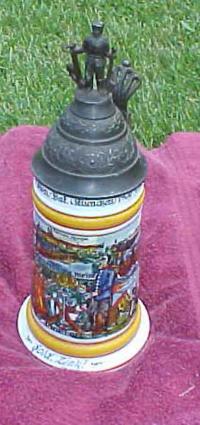
[B] This finial with the anchor is shown on many original reservist’s steins [see photo below ▼provided by Mr. Schaller of his grandfather’s stein, BUT the fan (open chair-back) thumblift is never seen on the older, original pieces.
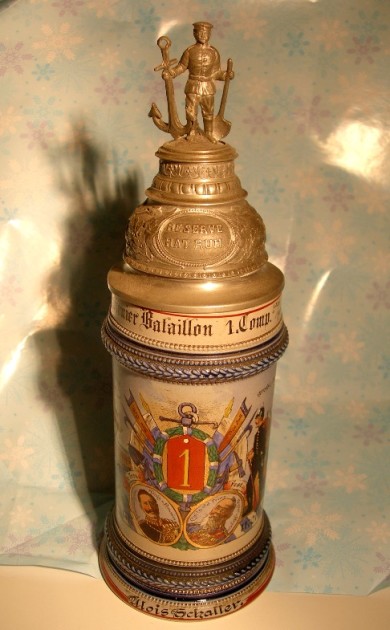
This entry’s mistake on my part .about the finial on this piece was corrected thanks to Mr. Schaller’s email to me. Thank you sir!
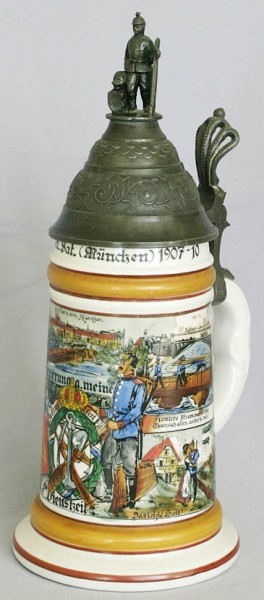
[C] Same body as just above, this time with an Infantryman as a finial.
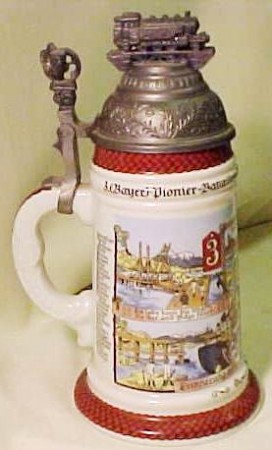
Another “Pioneer” unit with “Eisenbahn” finial. None existent state stripes, and no pedestal for the train trestle. Sits right on the flattened part of the lid.
_______________________________________________________________________
[22 ] As directly above] On Eisenbahn (railroad steins), the locomotive sits directly on the top of the lid and not on a pedestal.
______________________________________________________________________
[23] – Incorrect or none existent state stripes (See the four just above also) For example, a named ‘Baden’ stein might have ‘white / blue’ state stripes which are the true colors for the state of Bavaria.
.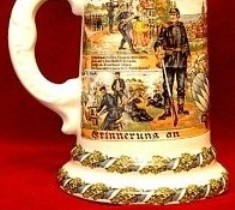
The reverse of [23] is true too. There are a few new ones that have two state stripes ridges at the bottom of the body. Never seen on an original.
___________________________ BUT WAIT !! ________________________________
And as we have learned in life, for every “rule” there are exceptions !
Some exceptions to #23:
Some originals made in 1890s had no state stripes, but may have a brownish background with black geometric pattern on the ribs.
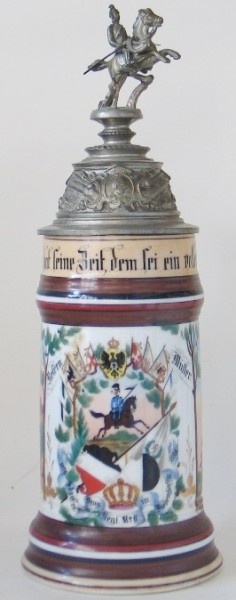
Old originals, 1890-1900, can be found like this with only colored bands .
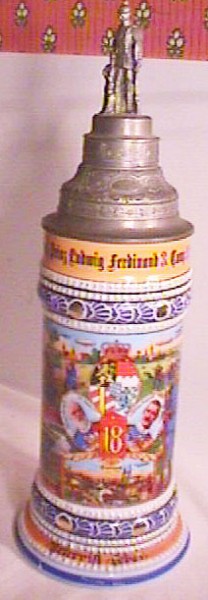
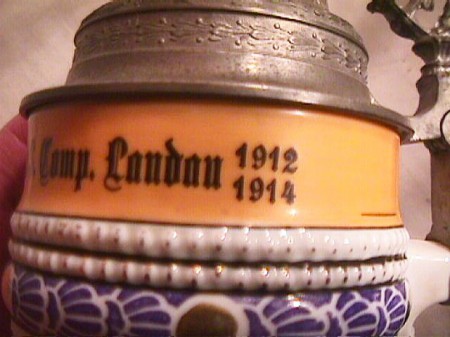
The reservist’s stein above violates rules number [17] = No difference in the writing within the unit designation. On the original steins from about 1900 the unit designation was hand painted into a blank space in the decaled (transfer) inscription. Usually the last two years were hand painted also. The style of the hand lettering is most often a little bolder and different than the decal, and [21] Incorrect or none existent state stripes. For example, a named ‘Baden’ stein might have ‘white / blue’ state stripes which are the true colors for the state of Bavaria. Yet this stein is quite authentic! And has a screw off lid finial.
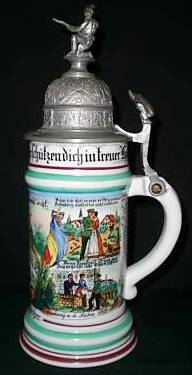
At first glance this Marburg Jager stein appears to be a repro. However, he hole through the handle is authentic and the state stripes of Saxony (Green and white) are running horizontal on this piece
________________________________________________________________________-
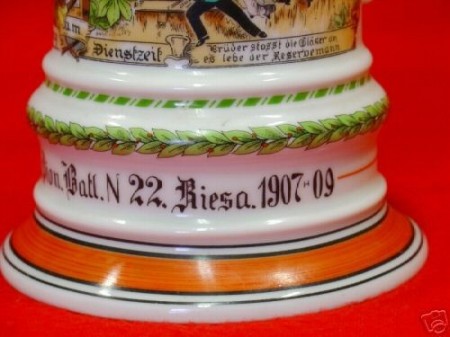
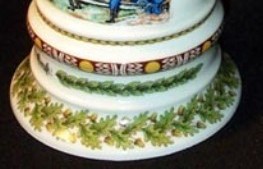
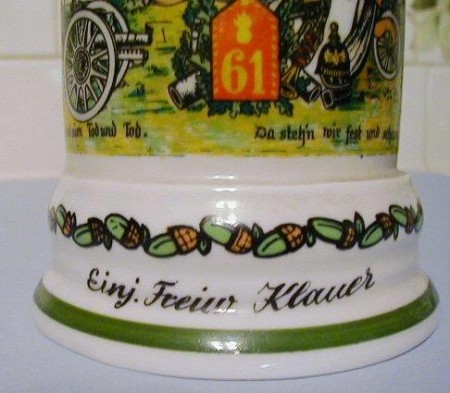
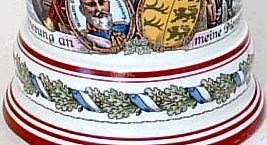
[24] Lastly: These hard to describe, but very fancy decorations [above] are hardly ever found on an original.
Below is one major exception, from A Bavarian unit:

An exception to about every rule .in science and beer steins !
________________________________________________________________
There is another category to be considered with in this realm: The “Mix and Match” steins (or their “let’s put this together and see what the hell it looks like !”
Example #1: of a “Mix and Match” = An older original reservist stein, with what looks like an original lid; a added repro ugly lion thumblift, as well as a new horse and rider never seen on originals. A pretty sloppy job of attaching it too.
___________________________________________________________________
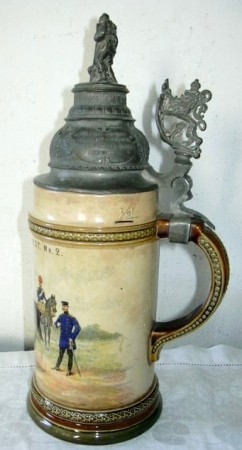
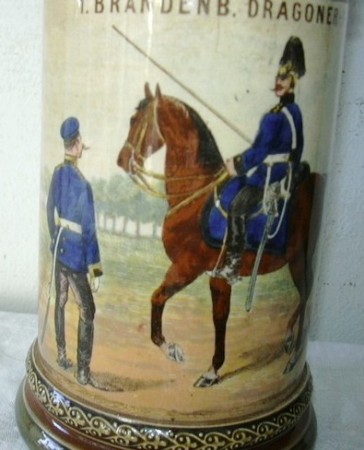
Example #2. Some one has taken an original Bavarian Infantry lid and placed it on a V & B Mettlach PUG military unit stein (these are not true “Regimentals” people!) that was made to celebrate service in a Brandenberg Dragon (Mounted horseman) Regiment. These non Guard units, V & B’s steins all came with a small domed pewter lid with a small ball thumblift. This lid’s size is way out of proportion!
And there will always be exceptions! Please see Page 2 for the latest update on the very newest reproduction Reservist steins! Bound to fool a lot of people.
 “I thought I wanted a career, turns out I just wanted pay checks.”
“I thought I wanted a career, turns out I just wanted pay checks.”

Leave a Reply